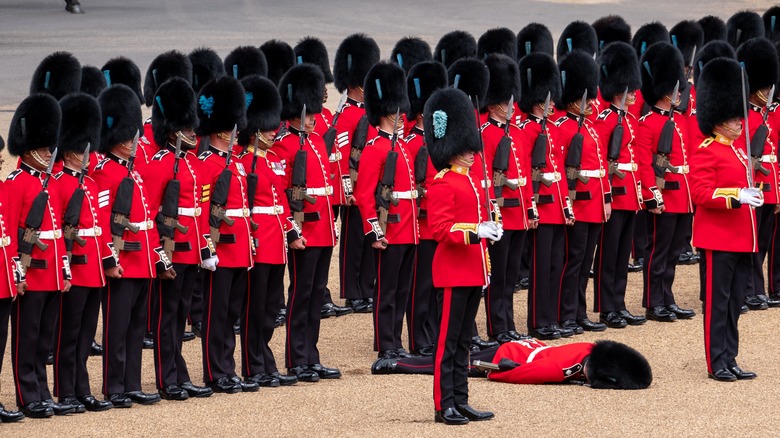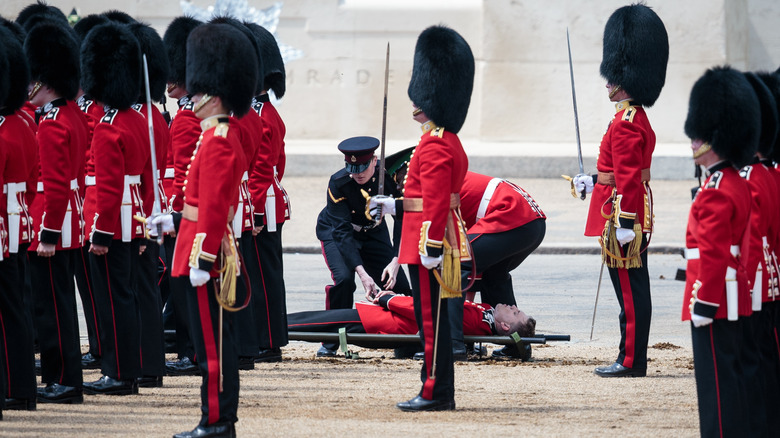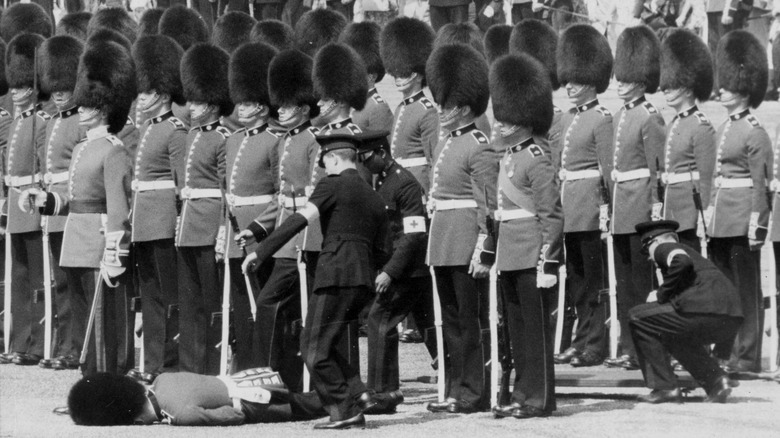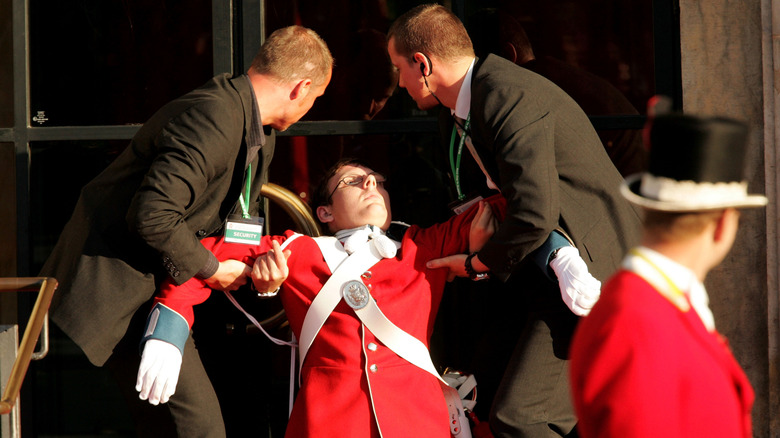The British Military Guards Must Follow Proper Protocol Even While Fainting
Plenty of jobs have strict rules and regulations, particularly those within a country's military forces, but there are few positions that require the composure, stamina, and decorum expected of the British military who have served as the Queen's Royal Guard during the reign of Queen Elizabeth II. Per the official website of The Household Division of the British Army, the Royal Body Guard dates back to the era of King Henry VII; it's a position of honor and is one of the oldest units within the Army. Protocols that all Royal Guards must follow include avoiding smiling and laughing, remaining nonreactive to people surrounding them unless an emergency requires shouting a command or pointing their rifles in warning, forgoing bathroom breaks, and learning how to faint properly (via The Vintage News).
How does one faint properly while guarding the British sovereign? A 2011 Express article reported that soldiers must learn how to "faint to attention," which is why photographs of lineups in which one of the guards has passed out usually show the unfortunate person lying face down on the ground with their arms at their sides. It's expected that if a soldier feels themselves going down, they pitch forward directly onto their front while still holding their rifle at attention. According to Major Dai Bevan of the Welsh Guards, "It will probably involve a broken nose and a whole lot of missing teeth." True dedication.
How to faint to attention
As reported by the Daily Mail, one of the guards holding vigil at Queen Elizabeth II's coffin as she lies in state at the Palace of Westminster fainted in front of a large crowd of shocked onlookers, several of whom had spent hours in line waiting to pay their respects to the queen. The man reportedly swayed on his feet just before he collapsed, first briefly stepping off the podium beside the coffin, rejoining the other guards, and eventually falling forward, perhaps "to attention" as he was instructed during his training. The live stream of the event paused momentarily as police officers went to assist. The other guards remained at attention, as is the protocol in such situations. According to Leading Britain's Conversation, soldiers from the Sovereign's Bodyguard, the Household Division, and the Yeoman Warders of the Tower of London remain at the queen's coffin for 24 hours each day as she lies in state. They remain entirely motionless at each corner of the casket's podium, rotating every 20 minutes but completing a total of six hours of standing for each shift.
How can guards avoid fainting in the first place under such grueling circumstances? Garrison Sergeant-Major Billy Mott told Express he recommends exercising in advance, staying hydrated, and wiggling one's toes and tensing the calves while standing, further explaining "If you are resting on your heels the blood doesn't flow back to the brain." Major Bevan advised staying alert and concentrating, sharing that he "did equations" while performing his guarding duties.
A royally prone history
Even though the recent spat of questions circulating around the British royal guards was kicked off by a guard collapsing at the Palace of Westminster, royal guards have struggled to stay standing for decades. The human body was meant to move, walk, lope across savannas in search of prey, or at least lay down and drool into a pillow.
We've got black and white photos all the way back to 1963 (above) depicting a guard with his face flat on the ground. In 2016, Inverse reported no less than two guards fainting during the first two days of Queen Elizabeth's 90th birthday bash. The first casualty of uprightness fell to the ground outside of St. Paul's Cathedral, and the second dropped during the Trooping the Color parade, when a whole bunch of guards march around in formation in honor of the monarch's birthday. The following year, in 2017, the Trooping the Color parade once again saw not the toppling of two troops, but at least five, as People reports. A spokesperson at the time very politely said, "We can confirm that during the queen's birthday parade today a small number of soldiers fainted. It is an extremely hot day and all were removed from the parade and checked by medical staff where they were hydrated."
By the next year, 2019, sites like CBS News speculated about how the royal guards could forestall the impending rash of collapsed bodies. This article, too, cited hot weather as the chief cause of collapse.
Face down across the globe
Just in case anybody is ready to take a jab at the British royal guards and call them big, big sissy faces for fainting in the sun, the Brits in the audience can take heart: Their royal retinue isn't the only one on record for dropping during prolonged ceremonies. During the christening of Sweden's Prince Julian in 2021, the Daily Mail produced a picture of a guard who had fainted, flat on his back, before the ceremony even began. Three years earlier, in 2018, a Swedish royal guard also fainted during the christening of Princess Adrienne, per Right Royal Roundup. The culprit in the latter case, again? You guessed it: heat. And adjacent to Sweden, east from England, Denmark saw one its own proud soldiers smack the tiles during a gala for the Danish Queen Margrethe. He was promptly dragged away before guests started arriving, as Daily Mail also reports.
So with all of these soldiers dropping left and right, and not from wounds sustained in combat, perhaps it's a good idea that there are protocols regarding how to fall forward and at attention. That way, the fallen's buddies can better sidestep the body while an attendant darts in to drag away the evidence before too many photos are snapped. Or better yet, perhaps many of these armed services should consider investing in lightweight, breathable materials that look the traditional part, but don't drag their men to the dirt.



